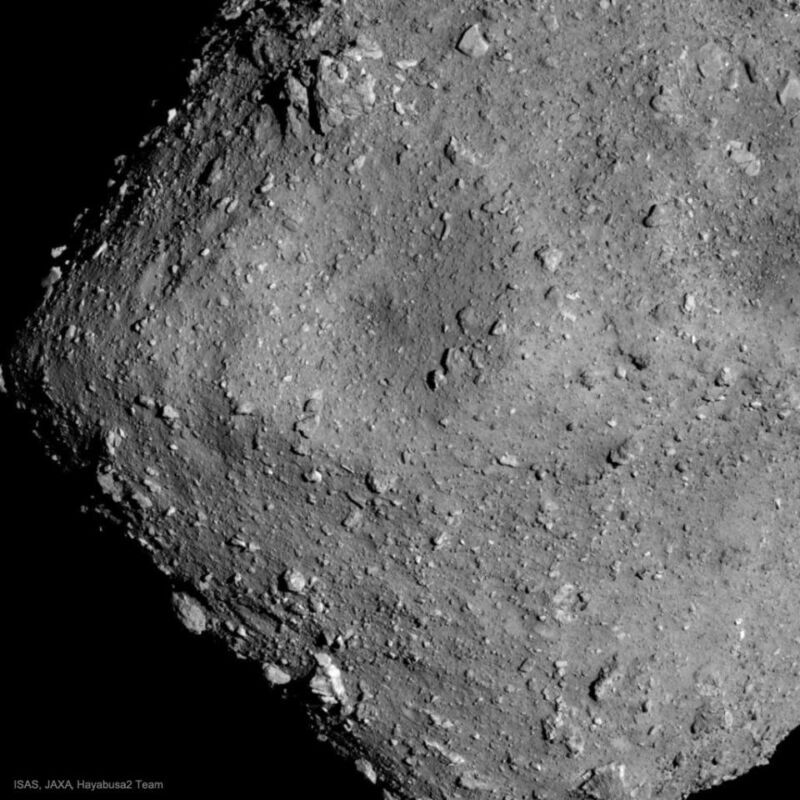4.08.2023
Small bits of material in the asteroid contain isotopes made in specific stars.

Ryugu's rubble pile includes some small fragments left over from our Solar System's formation.
When JAXA’s Hayabusa-2 spacecraft delivered samples from asteroid Ryugu to Earth in late 2020, anticipation was high. What could the space rock possibly be waiting to tell us?
Asteroids are time capsules of the Solar System, containing material from early in its history. As a 2021 study found, the Ryugu samples contained carbon, nitrogen, and oxygen, all necessary ingredients for life, and a 2022 study discovered evidence of water (and possibly a subsurface lake) that had long since dried up. Ryugu and its parent body were also revealed to carry some of the most ancient rocks in the Solar System. However, the pieces of this asteroid still had more to say.
It turned out that two of the Ryugu samples each had a shard of something that visually stood out. Researchers discovered they were seeing fragments, or clasts, of rock with a chemical composition that differed from the rest of Ryugu. These clasts were higher in sulfur and iron, but lower in oxygen, magnesium, and silicon. That meant they could not have possibly formed with Ryugu, so they had to have been acquired through a later impact; but the asteroid still had more to say.
Embedded in the clasts were tiny grains of rock made from stars that died before the Sun ever existed. “[The chemical makeup of] the primitive clasts compared to bulk Ryugu suggest that the clasts formed in a unique part of the protoplanetary disk enriched in presolar materials,” the research team said in a studyrecently published in Science Advances.
The stuff stars are made of
The clasts in Ryugu samples C0002 and A0040 are now thought to have originated in the outer reaches of the Solar System. By using different types of electron microscopy along with energy-dispersive X-ray spectroscopy and nanoscale secondary ion mass spectrometry, the researchers determined what they were made of. The presolar silicate grains inside the clasts contained significant amounts of the isotope Carbon-13. Most of the grains were silicon carbide. This told the team that the presolar grains had formed around asymptotic giant branch (AGB) stars (which our Sun will become someday), although one of them showed signs of possible supernova origin.
Most stars are main sequence stars. After they have burned through the hydrogen in their core through nuclear fusion, they evolve into AGB stars, which are similar to red giants. Powerful winds blow the outer layers of these stars off until there is nothing left but a white dwarf. The majority of presolar grains found in the Ryugu clasts appeared to have come from AGB stars with a similar or lower metal content than the Sun, such as two presolar grains within sample C0002 that were high in the isotope oxygen-17. The ratio of oxygen-17 to oxygen-18 provides evidence of nucleosynthesis in stars, as high levels of oxygen-18 are only produced in supernovae.
Some grains in Ryugu had an oxygen-17/18 ratio that matched that of AGB stars. Only one grain high in oxygen-18 showed a ratio consistent with a supernova.
Traveling through deep time and space
Traversing space was dangerous for those grains, because the materials in many of them cannot survive contact with water. This means the impact that brought them to Ryugu or its parent had to have happened sometime after the asteroid or parent lost its water. Because Ryugu’s parent body probably formed at the edge of the Solar System and was pushed inward later by gravitational interactions, the researchers think it may have once contained more presolar grains that water ended up obliterating.
There are some types of presolar grains that can survive water. Though presolar silicates won’t make it, silicon carbide and graphite grains that predate the Sun will, and these were also found on Ryugu. Strangely enough, Ryugu had some chemical similarities to the comet Wild 2, which was sampled by NASA’s Stardust mission, though it wasn’t an exact match. This finding could still mean that at least some of the presolar grains found in Ryugu samples could have originally come from a comet.
As we wait for samples from asteroid Bennu to touch down, it appears that Ryugu still has much to tell us about what the Solar System was like before we had a Sun.
Science Advances, 2023. DOI: 10.1126/sciadv.adh1003
Quelle: arsTechnica
